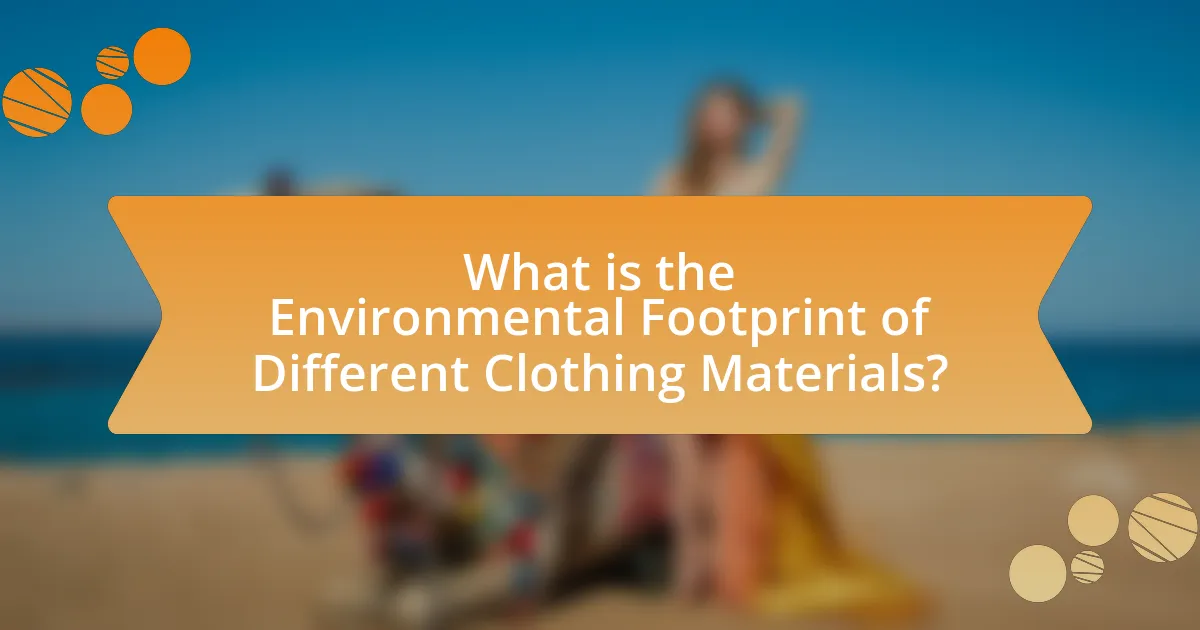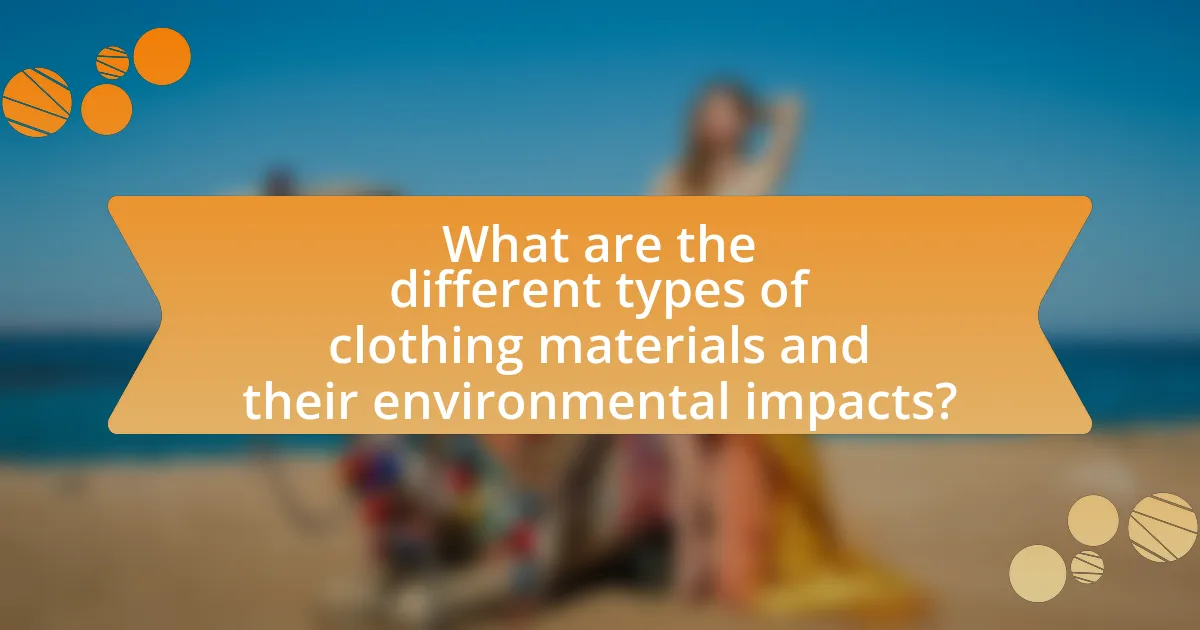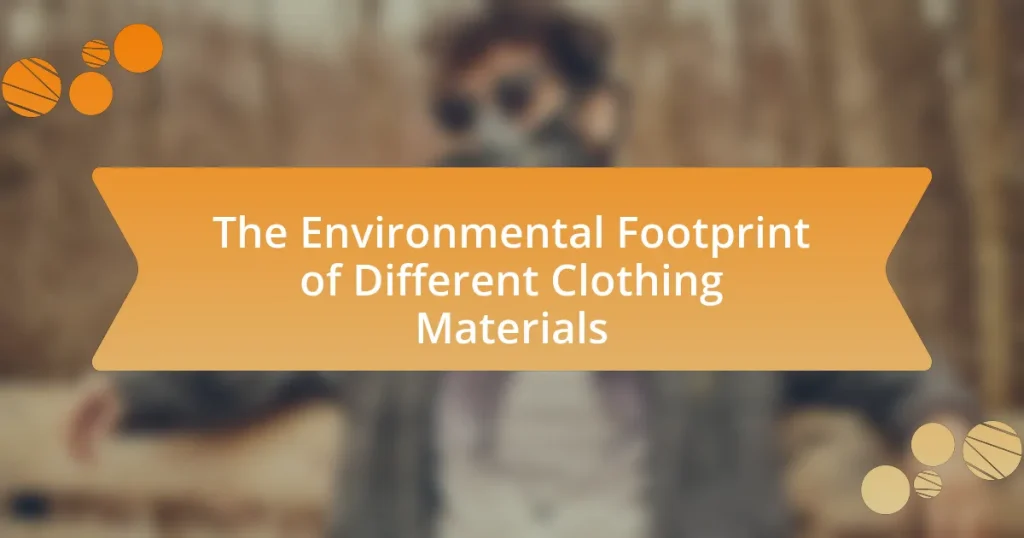The article examines the environmental footprint of various clothing materials, highlighting the significant differences in resource consumption, pollution, and waste generation associated with each type. It discusses the life cycle assessment (LCA) method used to measure these impacts, detailing how factors such as production processes and end-of-life disposal contribute to the overall environmental burden. Key materials analyzed include cotton, polyester, wool, and linen, with a focus on their respective water usage, greenhouse gas emissions, and biodegradability. The article emphasizes the importance of material choice for consumers and brands in promoting sustainability within the fashion industry, while also providing practical tips for reducing the environmental impact of clothing.

What is the Environmental Footprint of Different Clothing Materials?
The environmental footprint of different clothing materials varies significantly based on factors such as resource consumption, pollution, and waste generation. For instance, cotton requires substantial water and pesticide use, contributing to soil degradation and water scarcity; it takes approximately 7,000 liters of water to produce one kilogram of cotton. In contrast, polyester, derived from petroleum, has a lower water footprint but contributes to microplastic pollution in oceans, with an estimated 1.7 million tons of microfibers released annually from washing synthetic garments. Wool has a moderate footprint, with land use and methane emissions from sheep being notable concerns. Linen, made from flax, generally has a lower environmental impact due to its minimal water and pesticide requirements. These variations highlight the importance of material choice in reducing the overall environmental impact of clothing production and consumption.
How is the environmental footprint measured for clothing materials?
The environmental footprint of clothing materials is measured using life cycle assessment (LCA), which evaluates the environmental impacts associated with all stages of a product’s life, from raw material extraction to production, use, and disposal. LCA quantifies factors such as greenhouse gas emissions, water usage, and energy consumption, providing a comprehensive view of the material’s environmental impact. For instance, a study published in the Journal of Cleaner Production found that cotton production can require up to 20,000 liters of water per kilogram, highlighting the significant water footprint associated with this material.
What factors contribute to the environmental impact of clothing materials?
The environmental impact of clothing materials is influenced by factors such as resource extraction, production processes, transportation, and end-of-life disposal. Resource extraction involves the use of water, land, and energy, which can lead to habitat destruction and pollution; for instance, cotton farming consumes significant water resources and pesticides. Production processes, including dyeing and finishing, often release harmful chemicals into waterways, contributing to environmental degradation. Transportation adds to the carbon footprint due to emissions from shipping materials globally. Finally, end-of-life disposal, particularly for synthetic fibers, results in microplastic pollution and landfill waste, as many materials are not biodegradable. These factors collectively determine the overall environmental footprint of clothing materials.
How do production processes affect the environmental footprint?
Production processes significantly affect the environmental footprint by determining resource consumption, waste generation, and emissions. For instance, the manufacturing of synthetic fibers, such as polyester, requires substantial amounts of fossil fuels and water, contributing to greenhouse gas emissions and water scarcity. According to the Ellen MacArthur Foundation, the production of polyester emits approximately 706 million tons of CO2 annually, highlighting its substantial impact on climate change. Additionally, processes like dyeing and finishing often involve toxic chemicals, which can contaminate water sources, further exacerbating environmental degradation. Thus, the methods and materials used in production directly influence the overall environmental footprint of clothing.
Why is it important to understand the environmental footprint of clothing materials?
Understanding the environmental footprint of clothing materials is crucial because it informs consumers and manufacturers about the ecological impact of their choices. The production of textiles can lead to significant resource depletion, pollution, and waste generation; for instance, cotton farming requires approximately 7,000 liters of water to produce just one kilogram of cotton, contributing to water scarcity in many regions. Additionally, synthetic materials like polyester are derived from fossil fuels, which not only depletes non-renewable resources but also contributes to greenhouse gas emissions during production. By comprehending these impacts, stakeholders can make informed decisions that promote sustainability, reduce environmental harm, and encourage the adoption of eco-friendly materials and practices in the fashion industry.
What are the implications for consumers?
The implications for consumers regarding the environmental footprint of different clothing materials include increased awareness of sustainability and potential changes in purchasing behavior. Consumers are now more informed about the ecological impact of their clothing choices, leading to a preference for sustainable materials such as organic cotton or recycled polyester. This shift can result in higher demand for eco-friendly brands, influencing market trends and encouraging manufacturers to adopt greener practices. Additionally, consumers may face higher prices for sustainable options, reflecting the costs associated with environmentally responsible production methods.
How does it affect the fashion industry?
The environmental footprint of different clothing materials significantly affects the fashion industry by influencing consumer choices and brand sustainability practices. As awareness of environmental issues grows, consumers increasingly prefer brands that utilize eco-friendly materials, leading to a shift in production methods. For instance, the use of organic cotton and recycled polyester has been shown to reduce water consumption and carbon emissions compared to conventional materials. According to a report by the Ellen MacArthur Foundation, transitioning to a circular economy in fashion could generate $560 billion in economic benefits by 2030, highlighting the financial incentive for brands to adopt sustainable practices. This shift not only impacts brand reputation but also drives innovation in material sourcing and production processes within the industry.

What are the different types of clothing materials and their environmental impacts?
Clothing materials vary widely, each with distinct environmental impacts. Natural fibers like cotton require significant water and pesticides, contributing to soil degradation and water scarcity. For instance, conventional cotton farming uses about 7,000 liters of water per kilogram of cotton produced. Synthetic fibers such as polyester, derived from petroleum, have a high carbon footprint due to fossil fuel extraction and processing, and they contribute to microplastic pollution in oceans when washed. Wool, while biodegradable, has a substantial environmental impact due to methane emissions from sheep and land use for grazing. Additionally, materials like linen and hemp are more sustainable, as they require less water and pesticides, but their cultivation is still not without environmental concerns. Overall, the choice of clothing material significantly influences ecological sustainability, with natural fibers generally being more environmentally friendly than synthetics, though each has specific drawbacks.
How do natural fibers compare to synthetic fibers in terms of environmental footprint?
Natural fibers generally have a lower environmental footprint compared to synthetic fibers. The production of natural fibers, such as cotton and wool, typically requires less energy and generates fewer greenhouse gas emissions than the petroleum-based processes used to create synthetic fibers like polyester and nylon. For instance, a study by the Textile Exchange found that producing one kilogram of cotton emits approximately 1.8 kilograms of CO2, while producing one kilogram of polyester can emit up to 3.5 kilograms of CO2. Additionally, natural fibers are biodegradable, reducing long-term waste in landfills, whereas synthetic fibers can take hundreds of years to decompose. This distinction highlights the more sustainable nature of natural fibers in terms of their overall environmental impact.
What are the environmental impacts of cotton as a clothing material?
Cotton as a clothing material has significant environmental impacts, primarily due to its high water consumption, pesticide use, and land requirements. The cultivation of cotton requires approximately 7,000 liters of water to produce just one kilogram of cotton, leading to water scarcity in regions where it is grown. Additionally, conventional cotton farming utilizes around 16% of the world’s insecticides and 6% of pesticides, contributing to soil and water pollution. Furthermore, cotton farming occupies about 2.5% of the world’s arable land, which can lead to habitat destruction and biodiversity loss. These factors collectively highlight the substantial environmental footprint of cotton in the clothing industry.
How does wool’s environmental footprint differ from that of cotton?
Wool’s environmental footprint is generally lower than that of cotton due to its natural biodegradability and lower water usage. Wool production typically requires less water compared to cotton, which is one of the most water-intensive crops, consuming approximately 7,000 liters of water per kilogram of cotton produced. Additionally, wool is biodegradable and can decompose in soil, returning nutrients, while cotton, although also biodegradable, often involves chemical treatments that can hinder its environmental impact. Furthermore, wool farming can contribute to soil health through grazing practices, whereas cotton farming can lead to soil degradation and pesticide use.
What are the environmental consequences of synthetic materials like polyester?
Synthetic materials like polyester contribute significantly to environmental degradation through pollution, resource depletion, and waste generation. The production of polyester involves the use of fossil fuels, which leads to greenhouse gas emissions; for instance, the manufacturing process can emit up to 3.5 kg of CO2 for every kilogram of polyester produced. Additionally, polyester is non-biodegradable, persisting in landfills for hundreds of years and contributing to microplastic pollution in oceans, where it can harm marine life. Studies indicate that around 35% of microplastics in the ocean originate from synthetic textiles, including polyester. Thus, the environmental consequences of polyester are profound, affecting air quality, water systems, and biodiversity.
How does the production of polyester affect the environment?
The production of polyester significantly impacts the environment through high energy consumption, greenhouse gas emissions, and pollution. Polyester is derived from petroleum, a non-renewable resource, and its manufacturing process requires substantial energy, contributing to approximately 1.5 billion tons of carbon dioxide emissions annually. Additionally, the production process releases harmful chemicals into water systems, leading to water pollution. According to a study by the Ellen MacArthur Foundation, the textile industry, including polyester production, is responsible for 20% of global wastewater. Furthermore, microplastics released during washing contribute to ocean pollution, affecting marine life.
What are the long-term effects of synthetic materials on ecosystems?
The long-term effects of synthetic materials on ecosystems include habitat degradation, pollution, and disruption of food chains. Synthetic materials, such as plastics and microfibers, persist in the environment for hundreds of years, leading to accumulation in soil and waterways. For instance, studies have shown that microplastics can be ingested by marine organisms, which can then affect entire food webs and biodiversity. Research published in “Environmental Science & Technology” by Dr. Jenna R. Jambeck indicates that approximately 8 million metric tons of plastic enter the oceans annually, significantly impacting marine life and ecosystems. Additionally, the breakdown of synthetic materials releases harmful chemicals that can leach into soil and water, further harming flora and fauna.

What are the best practices for reducing the environmental footprint of clothing materials?
The best practices for reducing the environmental footprint of clothing materials include selecting sustainable fibers, implementing efficient production processes, and promoting circular fashion. Sustainable fibers, such as organic cotton, Tencel, and recycled polyester, require fewer resources and generate less pollution compared to conventional materials. Efficient production processes, such as waterless dyeing and energy-efficient manufacturing, minimize resource consumption and waste generation. Circular fashion practices, including recycling and upcycling, extend the lifecycle of clothing and reduce landfill waste. According to the Ellen MacArthur Foundation, transitioning to a circular economy in fashion could reduce greenhouse gas emissions by 44% by 2030.
How can consumers make more sustainable choices in clothing?
Consumers can make more sustainable choices in clothing by opting for eco-friendly materials, supporting ethical brands, and prioritizing second-hand purchases. Eco-friendly materials, such as organic cotton, Tencel, and recycled polyester, have a lower environmental impact compared to conventional fabrics, which often involve harmful chemicals and high water usage. Supporting ethical brands that prioritize fair labor practices and sustainable production methods ensures that consumers contribute to a more responsible fashion industry. Additionally, purchasing second-hand clothing reduces waste and extends the lifecycle of garments, significantly lowering the overall environmental footprint associated with new clothing production. According to the Ellen MacArthur Foundation, extending the life of clothing by just nine months can reduce carbon, water, and waste footprints by around 20-30%.
What should consumers look for when choosing clothing materials?
Consumers should look for sustainability, durability, and comfort when choosing clothing materials. Sustainable materials, such as organic cotton or recycled polyester, have a lower environmental impact compared to conventional fabrics, which often involve harmful pesticides and high water usage. Durability ensures that clothing lasts longer, reducing waste and the frequency of replacement, while comfort affects wearability and overall satisfaction. Research indicates that organic cotton uses 91% less water than conventional cotton, highlighting the importance of material choice in reducing environmental footprints.
How does second-hand shopping impact the environmental footprint?
Second-hand shopping significantly reduces the environmental footprint by extending the lifecycle of clothing and minimizing waste. When consumers purchase used items, they decrease the demand for new production, which is responsible for high levels of resource consumption, including water and energy. For instance, producing a single cotton t-shirt requires approximately 2,700 liters of water, while second-hand shopping helps avoid this resource-intensive process. Additionally, the fashion industry contributes to about 10% of global carbon emissions; by opting for second-hand clothing, consumers can help lower these emissions by reducing the need for new manufacturing. Thus, second-hand shopping plays a crucial role in promoting sustainability and reducing the overall environmental impact associated with clothing production.
What role do brands play in minimizing the environmental impact of clothing materials?
Brands play a crucial role in minimizing the environmental impact of clothing materials by adopting sustainable practices and promoting eco-friendly materials. By sourcing organic cotton, recycled polyester, and other sustainable fabrics, brands can significantly reduce water usage, chemical pollution, and carbon emissions associated with traditional textile production. For instance, the use of organic cotton can reduce water consumption by up to 91% compared to conventional cotton farming, as reported by the Textile Exchange. Additionally, brands that implement circular economy principles, such as recycling and upcycling, contribute to waste reduction and resource conservation. This proactive approach not only lessens the environmental footprint of their products but also influences consumer behavior towards more sustainable choices.
How can brands adopt sustainable practices in their production processes?
Brands can adopt sustainable practices in their production processes by implementing eco-friendly materials, optimizing resource efficiency, and reducing waste. Utilizing organic cotton, recycled polyester, or Tencel can significantly lower the environmental impact compared to conventional materials. For instance, organic cotton uses 91% less water than traditional cotton farming, according to the Textile Exchange. Additionally, brands can enhance energy efficiency by using renewable energy sources in manufacturing, which can reduce greenhouse gas emissions. Implementing a circular economy approach, such as recycling and upcycling materials, further minimizes waste and promotes sustainability. Research from the Ellen MacArthur Foundation indicates that transitioning to a circular economy in fashion could reduce global carbon emissions by 44% by 2030.
What certifications should consumers look for to ensure sustainability?
Consumers should look for certifications such as Global Organic Textile Standard (GOTS), OEKO-TEX Standard 100, and Fair Trade Certified to ensure sustainability in clothing materials. GOTS certifies that textiles are made from organic fibers and meet environmental and social criteria, while OEKO-TEX Standard 100 ensures that textiles are free from harmful substances. Fair Trade Certified indicates that the products were made under fair labor conditions and sustainable practices. These certifications provide a reliable framework for assessing the sustainability of clothing materials, promoting environmentally friendly and ethically produced textiles.
What are practical tips for reducing your clothing’s environmental footprint?
To reduce your clothing’s environmental footprint, prioritize sustainable practices such as buying second-hand clothing, choosing eco-friendly materials, and minimizing washing frequency. Purchasing second-hand clothing extends the life cycle of garments and reduces waste, as the fashion industry contributes to 92 million tons of textile waste annually. Selecting eco-friendly materials like organic cotton or Tencel can significantly lower water usage and chemical pollution; for instance, organic cotton uses 91% less water than conventional cotton. Additionally, washing clothes less frequently conserves water and energy; washing accounts for about 20% of a garment’s total environmental impact.



